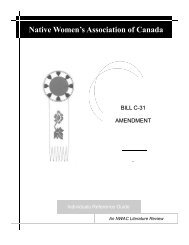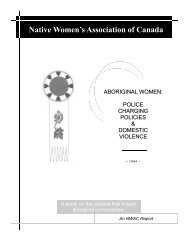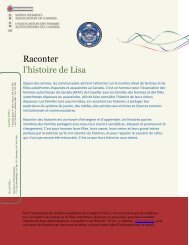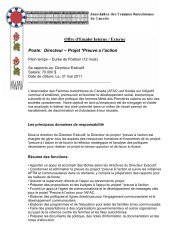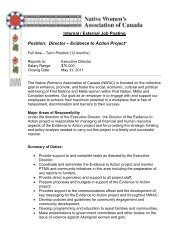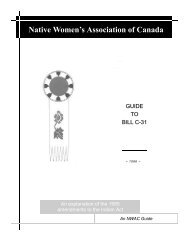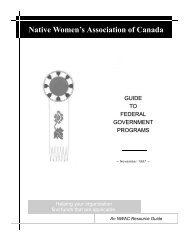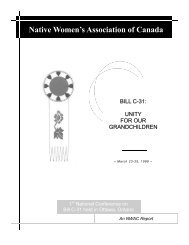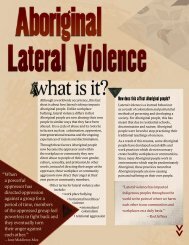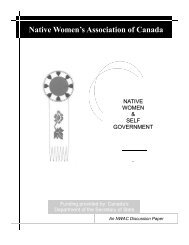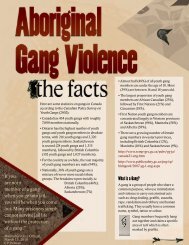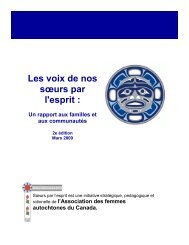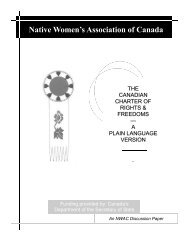1 Test Your Knowledge Worksheets Residential School ...
1 Test Your Knowledge Worksheets Residential School ...
1 Test Your Knowledge Worksheets Residential School ...
Create successful ePaper yourself
Turn your PDF publications into a flip-book with our unique Google optimized e-Paper software.
<strong>Test</strong> <strong>Your</strong> <strong>Knowledge</strong> <strong>Worksheets</strong><strong>Residential</strong> <strong>School</strong>BackgrounderA. Which of the followingstatement(s) is false:1. <strong>Residential</strong> schools operatedfor over 100 years and werecreated in nearly everyprovince and territory exceptNewfoundland, New Brunswickand Prince Edward Island.2. If families didn’t send children toresidential school, children couldbe forcefully taken. Parents whoresisted could be jailed.3. Aboriginal children in residentialschools were poorly fed, underclothed, and over worked fordecades.4. Some former students/survivors of have expressedgratitude to former teachersof residential schools5. <strong>Residential</strong> schools and successivecolonial policies have led to theassimilation of First Nations, Inuitand Métis Peoples.6. <strong>Residential</strong> schools were createdto destroy Aboriginal nations inorder to eliminate Canada’s treatyobligations to First Nations7. Children experienced horrificabuse by residential school staffincluding physical, psychological,emotional, and sexual abuse.52B. The Indian <strong>Residential</strong><strong>School</strong> SettlementAgreement: True or False?1. The Settlement Agreement wasreached in 2006 in response tonumerous class-action lawsuitsthat former students of residentialschools brought against the federalgovernment and the churches thatoperated the schools.True or False?2. The Indian <strong>Residential</strong> <strong>School</strong>Settlement Agreement involvedday students and boardedstudents of Church run schoolsfor Aboriginal children.True or False?3. The government of Canada wasmandated to pay a reparationcalled a Common ExperiencePayment to all of those who wentto a residential school recognizedunder the Agreement.True or False?4. Survivors who suffered additionalwrongful acts and abuse weregiven until September 19, 2012,to apply to the IndependentAssessment Process (IAP)which will review eligibility foradditional compensation.True or False?5. The Truth and ReconciliationCommission of Canada has amandate to learn the truth aboutwhat happened in the residentialschools , and to inform allCanadians about these truths.True or False?<strong>Residential</strong> <strong>School</strong>s’Impacts onFirst Nations, Métisand Inuit Womenand Girls TodayC. Which of the followingresidential school practicesdid not have a genderedimpact of the lives of FirstNations, Inuit and MétisPeople?1. <strong>Residential</strong> schools separatedbrothers from sisters and boysfrom girls, while training boys tobe property heads.2. <strong>Residential</strong> schools led to aloss of transmission of FirstNations, Inuit and Métis genderspecific teachings, customs andceremonies and tried to destroythe matrilineal systems of manyNations, in which property wascontrolled and passed throughthe women’s line.3. The high levels of violence againstFirst Nations, Inuit and Métiswomen and girls today is a resultof the residential schools andcolonial policies.4. Many girls in residential schoolswere farmed out as domesticlabour to non-Aboriginal homes,and trained to wait as housemaidson future husbands.5. Over 150,000 Aboriginal boysand girls were taken away toresidential schools.6. <strong>Residential</strong> school trauma andabuse has had differential effectson each gender.1
D. True or False:Aboriginal women inconflict with the law whoare inter-generationalresidential schoolsurvivors:1. Generally have a lot of knowledgeabout the historyof residential schoolsTrue or False?2. Often feel compassion andunderstanding for their parentsor grandparents who went toresidential schoolsTrue or False?3. Report high rates of childhoodabuse, family breakdown andaddictions True or False?4. Are often re-traumatized bythe correctional systemTrue or False?5. Spend more time in jail on povertyrelated offences and on breachesof administrative orders, than forserious or violent crimes True orFalse?6. Need support, and positivementoring to move forwards withtheir lives. True or False?GenderConsiderationsand GladueE. Gladue Principle:True or False:1. Gladue rights apply to allAboriginal people: status ornon-status Indians, First Nations,Métis, or Inuit, regardless ofresidence in an Aboriginalcommunity or a non-Aboriginalcommunity.True or False?2. Gladue instructs judges settingbail or sentencing offenders toconsider all available sanctionsother than imprisonment that arereasonable in the circumstances,with particular attention to thecircumstances of Aboriginaloffenders.True or False?3. The Supreme Court ruled in favourof Gladue in recognition thatAboriginal Peoples in Canada facesystemic discrimination in theireveryday lives, and in the justicesystem. True or False?4. Aboriginal people cannot waivetheir Gladue rights.True or False?5. A community sentence mightinvolve mandating an Aboriginalperson who has admitted guilt,to drug or alcohol rehabilitation,anger management, counsellingprograms, transformative orrestorative justice processes,or other community courts orrehabilitative programs.True or False?F. When applying Gladuein sentencing, judgesneed to weigh which ofthe following culturallyrelevant, gender-basedconsiderations?1. The high levels of systemicviolence against Aboriginalwomen and girls, and therole that played in theircriminalization (was it selfdefense, was it a crime linked toa battered syndrome?).2. The link between historicracism, poverty and Aboriginalwomen’s criminalization onpoverty related charges (ie;prostitution, rent fraud etc.).3. The high levels of sexual abuseand physical abuse of Aboriginalwomen and girls, and the linkthat has to later addictions andincarceration. (intoxication attime of arrest, drug dealing etc).4. The duty to protect Aboriginalwomen and children fromall forms of violence anddiscrimination; (and otherrelevant international humanrights obligations).5. Availability of effective non coed,gender specific rehabitationand treatment programs forAboriginal men and womento deal with the impact ofresidential schools.53



